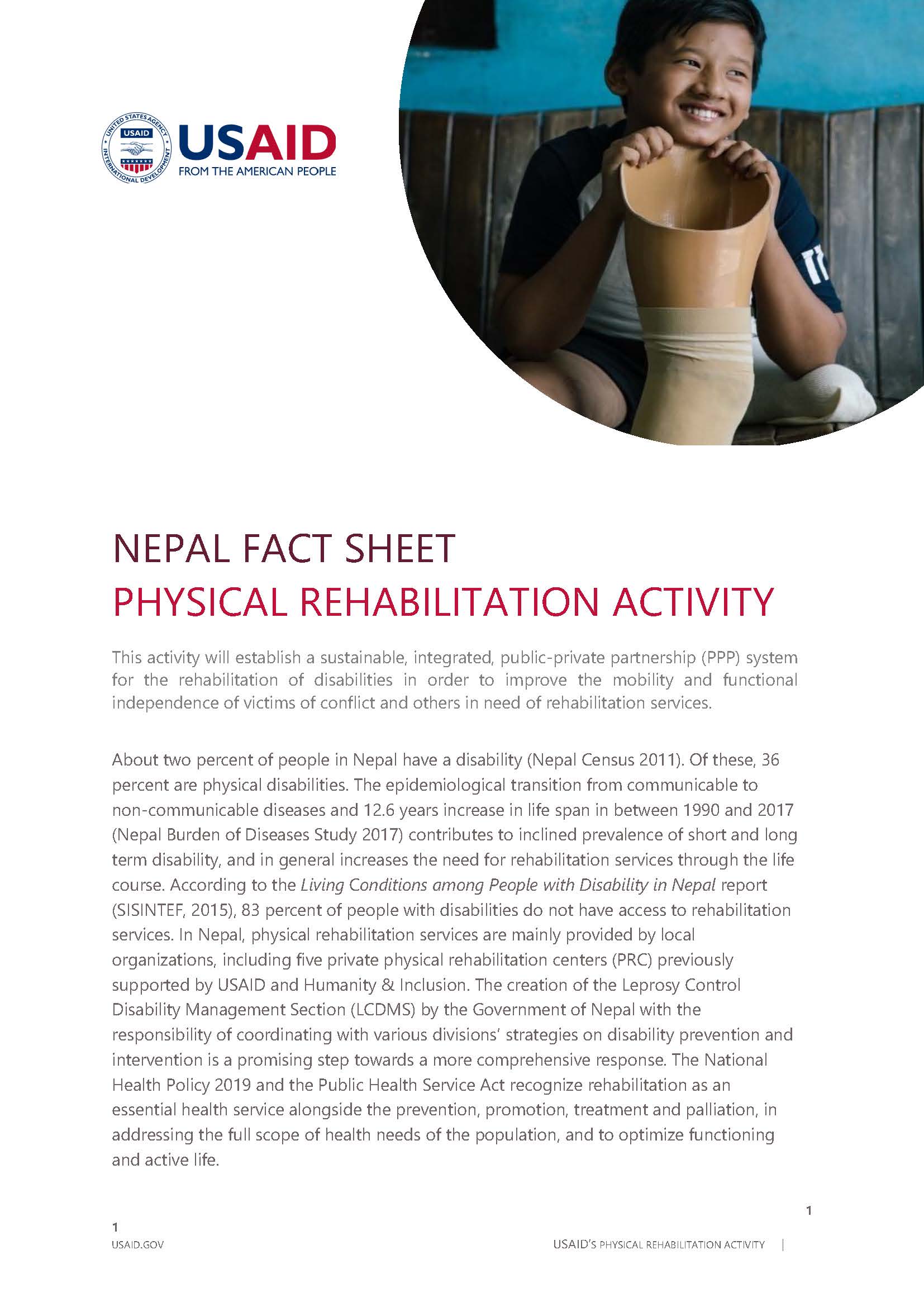Speeches Shim
This activity will establish a sustainable, integrated, public-private partnership (PPP) system for the rehabilitation of disabilities in order to improve the mobility and functional independence of victims of conflict and others in need of rehabilitation services.
Fact Sheet: Physical Rehabilitation Activity ![]() (pdf - 162k)
(pdf - 162k)
About two percent of people in Nepal have a disability (Nepal Census 2011). Of these, 36 percent are physical disabilities. The epidemiological transition from communicable to non-communicable diseases and 12.6 years increase in life span in between 1990 and 2017 (Nepal Burden of Diseases Study 2017) contributes to inclined prevalence of short and long term disability, and in general increases the need for rehabilitation services through the life course. According to the Living Conditions among People with Disability in Nepal report (SISINTEF, 2015), 83 percent of people with disabilities do not have access to rehabilitation services. In Nepal, physical rehabilitation services are mainly provided by local organizations, including five private physical rehabilitation centers (PRC) previously supported by USAID and Humanity & Inclusion. The creation of the Leprosy Control Disability Management Section (LCDMS) by the Government of Nepal with the responsibility of coordinating with various divisions’ strategies on disability prevention and intervention is a promising step towards a more comprehensive response. The National Health Policy 2019 and the Public Health Service Act recognize rehabilitation as an essential health service alongside the prevention, promotion, treatment and palliation, in addressing the full scope of health needs of the population, and to optimize functioning and active life.
Project Overview
USAID’s Physical Rehabilitation Activity is a five-year, $4 million program that works to improve access to, and quality and sustainability of the rehabilitation system in Nepal. Between June 2019-June 2024, the activity will help to establish a sustainable rehabilitation services system through a health system strengthening approach using the WHO Rehabilitation 2030 strategy as well as the WHO health system strengthening approach targeting six core areas: (i) governance and leadership; (ii) health and rehabilitation human resources; (iii) rehabilitation information system development; (iv) medical and product technologies, including assistive products; (v) finance; and (vi) service delivery. The activity will mentor and strengthen PRC throughout Nepal and foster relationships between these PRCs and public sector Physiotherapy Units (PTU). The activity with work jointly with the Ministry of Health and Population – Department of Health Services - Epidemiology and Disease Control Division (EDCD) /LCDMS.
USAID’s Physical Rehabilitation Activity is being implemented by Humanity and Inclusion and local implementing partners National Federation of the Disabled-Nepal, National Disabled Fund, Community Based Rehabilitation- Biratnagar, PRERANA, Nepalgunj Medical College Teaching Hospital and Nepal National Social Welfare Association. The activity is being implemented in all seven provinces of Nepal
Project Objectives
- Enhance the quality of rehabilitation services
- Increase access to rehabilitation service
- Strengthen the sustainability of the Physical Rehabilitation Services
Key Outcomes
- Support the LCDMS, provincial and local governments to revises/developed and implement policies, plans, budget and guidance on physical rehabilitation centers and physiotherapy Units (PTU).
- Integrate 70% of private PRCs into the PPP systems developed by LCDMS with support from PRA to expand access of physical rehabilitation services.
- Provide vital rehabilitation services to at least 31,100 people (of which at least 42% are female) through government PTUs and private PRCs operating under the LCDMS’s PPP model.
- Improve mobility and functional independence of 75% of women, men, boys and girls who received rehabilitation services provided through the public health system.


Comment
Make a general inquiry or suggest an improvement.